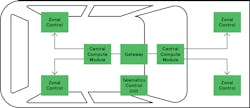High-Performance Computing Pushes the Pedal for In-Vehicle Networking
What you’ll learn:
- How the use of electronic control units has shifted over the past 50 years.
- What legacy protocols like CAN, FlexRay, MOST, and LIN are still in play.
- Why automotive OEMs are moving away from distributed ECUs to domain-based architectures.
Over the past four decades, vehicle design has undergone significant change, from incremental mechanical enhancements to a reliance on ever-more sophisticated electronic systems. The automotive industry is experiencing rapid changes to in-vehicle networking as engineers strive to meet the demands of modern vehicles, including battery-electric and fully autonomous self-driving capabilities.
We have entered the era of in-car high-performance computing (HPC). Auto manufacturers are putting what are essentially servers into vehicles to handle the enormous amount of processing now needed by the vehicle’s complex electronic systems.
Since the mid-1970s, the electronic control unit (ECU) has played a crucial role in optimizing engine functions like fuel injection and timing. As electronic systems became more prevalent, ECUs expanded to cover various vehicle functions, from transmission and suspension to comfort controls and traction controls. However, as the number of ECUs increased, the need for improved in-vehicle networking became evident.
How are In-Vehicle Networks Changing?
To address demand, the Society of Automotive Engineers (SAE) established the J1939 specification in the mid-1990s, introducing the message-based Controller Area Network (CAN) protocol. CAN has served as a high-speed, in-vehicle networking standard for decades. Alongside CAN, other legacy protocols like FlexRay, Media Oriented System Transport (MOST), and Local Interconnect Network (LIN) have been used for lower-speed serial bus and multi-drop network communications.
Over time, CAN has evolved from its initial maximum data rate of 150 kb/s to the CAN-FD (flexible data rate) standard, offering speeds of 10 Mb/s. Recently, the CAN XL standard was ratified, pushing the bandwidth further to 20 Mb/s. However, with increasing demand for advanced driver-assistance systems (ADAS) relying on vision-based sensors, mmWave radar, and LiDAR, ultra-reliable, high-bandwidth, and low-latency networking solutions are required.
Ethernet, the dominant IP-based enterprise networking protocol, has been adapted for automotive applications. Automotive Ethernet (100BASE-T1, 1000BASE-T1, and 10BASE-T1S—10 Mb/s to 1 Gb/s) brings lower-cost, compact, and lighter single-pair Ethernet (SPE) cables, primarily differing in the physical layer. SPE is gaining rapid adoption not only in the automotive industry, but also in other sectors such as industrial automation.
Despite the advantages of Ethernet, the increasing number of electronic systems still demands a significant amount of copper wiring. Heavy wiring harnesses are required to connect ECUs, sensors, actuators, and infotainment interfaces, posing challenges for automotive executives.
This challenge becomes even more critical in battery electric vehicles, where weight directly affects the vehicle's range. As a solution, automotive engineers are transitioning from a domain-centric approach to a zonal architecture.
Zonal Architectures Pave the Way to Software-Defined Vehicles
Automotive OEMs are moving away from distributed ECUs to domain-based architectures. The expectation is the domain approach will rapidly lead to zonal architectures. A zonal architecture treats each physical part of a vehicle as a zone. It controls the entire vehicle from a central high-performance computer and uses zonal controllers, or gateways, to manage each part of the vehicle.
The zonal architecture relies on a redundant Ethernet network backbone to serve each zone and connect major vehicle functions. Multiple ECU functions are consolidated into a central HPC server, with specific edge tasks delegated to zonal controllers. This approach reduces weight, complexity, and enables the transformation of certain vehicle functions into software services, ultimately contributing to the development of the software-defined vehicle and achieving full autonomy.
Beyond the physical-layer advantages, automotive Ethernet leverages features such as time-sensitive networking (TSN), which ensures deterministic network behavior crucial for critical safety functions. While Ethernet is expected to replace CAN in the future, CAN and other slower-speed networks will continue to be deployed where Ethernet remains either too costly or too complex.
The need for high-performance computing and zonal architectures stems from developments in sensors and automated driving. A recent announcement by the Fraunhofer Institute for Photonic Microsystems (IPMS) outlined its plans to develop supportive technologies.
The Verano project from the IPMS will use artificial intelligence to create radar sensor networks for fully autonomous vehicles. The nodes on the network will communicate to the in-vehicle high-performance computer through zonal gateways, over Ethernet TSN connections. The team at Fraunhofer IPMS will leverage its existing TSN IP cores to enable deterministic connections that offer real-time communications with very low latency, exhibiting low jitter but with bandwidths in the region of 10 Gb/s. Redundancy and functional safety to ISO 26262 will also be part of the specification.
In addition, the need for high-speed application-specific interface protocols has paved the way for new standards. An example is the Mobile Industry Processor Interface (MIPI) A-PHY, a high-speed unidirectional data link supporting speeds of up to 16 Gb/s and power delivery using a single unshielded twisted-pair (UTP) cable. MIPI A-PHY natively supports the MIPI CSI-2 camera and DSI-2 display interfaces, suiting it for ADAS and infotainment applications.
PCIe Key to Next-Gen Automotive SoCs
The evolution toward zonal architectures will change the shape of in-vehicle networks, However, the need for highly integrated systems-on-chip (SoCs) will increase, too. The complexity and capability of radar sensor networks, high-resolution cameras, and LiDAR systems will demand higher levels of compute power in the sensors and network nodes.
Moving data into and out of memory quickly has been a driving force in the semiconductor industry for decades. It takes time and energy to move data around, and ADAS and fully autonomous vehicles will only push the need for fast and wide data highways upward.
Two high-speed intra-SoC interfaces will be important in this area. PCI Express (PCIe) and Compute Express Link (CXL). Of these two, PCIe probably has the best foothold in automotive applications.
There are some indications that bridges could be used between PCIe and Ethernet TSN to extend the reach of PCIe outside the SoC, at least in spirit if not in body.
Data Centers on Wheels
As vehicle technologies advance, the transformation of analog gauges and switches into sleek, intuitive touchscreens becomes evident. Modern vehicles are equipped with ADAS, including emergency braking and blind-spot detection, making them significantly safer. Due to the enormous amount of data generated, cars are often referred to as data centers on wheels, emphasizing the critical role of reliable and robust networking in ensuring safe and reliable vehicle operation.

